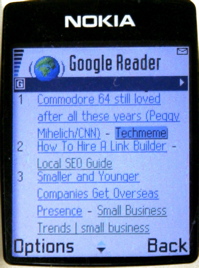Understanding Google My Business & Local Search
My (ancient) cell phone as a reading device.
I have an old Nokia 3650 cell phone with a pre-columbian Java and an even older Symbian OS rev. Although it might just as well be called the Simian OS for all the good that my opposable thumbs do me. While it basically sucks I have learned how to take advantage of its many Web 0.5 features like WAP browsing.
I have experimented with most aspects of mobile internet, mobile local and mobile search on my phone. Most web implementations and search options for this generation of technology are either useless or so difficult to use that they might as well be. They do however tend to highlight interface issues with using mobile devices for browsing, emailing, reading etc. and when it does work it is awe inspiring. There is still something very Buck Rogerish about reading Bill Slawski’s recent post on Google Health & Privacy while heading down the highway (my wife IS driving of course).
 Any task that requires significant input like internet searching, extensive email responses and Google SMS local search get used only when the “pain is worth the gain”. Other activities like Goog-411 that are not only painless but “fun” get used more regularly.
Any task that requires significant input like internet searching, extensive email responses and Google SMS local search get used only when the “pain is worth the gain”. Other activities like Goog-411 that are not only painless but “fun” get used more regularly.
The one surprising thing that my antiquated cell phone does well is allow me to read. Virtually all of the uses that I have found for it include active reading with little or no input….I read emails (then call the client), read my kids text messages (then fume :)) and most significantly keep abreast of my Google Reader list of “must read” local search news for the day.
Reading “Mobile web design is so different from the desktop web” (Martin Kleppmann of www.yes-no-cancel.co.uk) clarified my understanding of why some things work and some don’t on my ancient mobile browsing environment.
Google in their WAP mobile Google Reader implementation demonstrates Martin’s point:
For mobile users it is even more important than for normal web users that the designer has figured out exactly what the most frequently needed aspects of his site are, and made those aspects immediately and very easily accessible. This means that a mobile page can contain far fewer navigational elements (links) than a page intended for desktop viewing.
Google has really figured out how to present a significant amount of information with little or no input required other than cursoring up or down or selecting something. They have done so with only 5 or 6 links to a page. They not only make every link important for navigation, they provide meaningful information at every level of the experience. The links aren’t just navigational links (Like Ask’s WAP browser search interface) that take you deeper to find what you are looking for, they offer content and meaning in and of themselves.
 Google Reader has been a godsend as I sit and wait for my preteen and teenage children to finish practice or as I sit bored during half time of one of their many games. These are not book length articles but with the headline and source I am able to decide to read the summary and then if appropriate, the full article. It is not painful and borders on fun. The navigation and delivery just work and the screen is more than up to the task of making the content readable.
Google Reader has been a godsend as I sit and wait for my preteen and teenage children to finish practice or as I sit bored during half time of one of their many games. These are not book length articles but with the headline and source I am able to decide to read the summary and then if appropriate, the full article. It is not painful and borders on fun. The navigation and delivery just work and the screen is more than up to the task of making the content readable.
It appears that iPhone users agree with me and a significant number are using the device for reading medium length content. The most popular download for the iPhone beyond gaming is Zinio, allowing users to view magazines.
If the message is properly fitted to the medium, reading can become (and is becoming) an important use of mobile devices. This has implications for local search. If local content beyond phone/address/directions were properly formatted it could be useful and would be used in local mobile. If my decrepit cell phone provides a functional experience when presented with the correct web design then any phone can. If Google can do it with Reader then others (or Google) can do it with meaningful local content.
© Copyright 2025 - MIKE BLUMENTHAL, ALL RIGHT RESERVED.
Comments
2 Comments
Yes, I agree with your observation that the mobile web suddenly allows us to use all that spare time during which we would otherwise just hang around doing nothing. In your case, waiting for the children. Reading news is a good thing to do on mobile because, as you say, it requires hardly any input. I think we’ll be seeing lots more things to do on the mobile web soon, such as browsing online shops… once people have figured out how to do that with the same ease and minimal input as reading news!
Hi Martin
Man you are quick! I recently found your site and have enjoyed your postings.
I agree that we will but obviously, if my experience is any indication , creating workable solutions is not for everybody. It is amazing to me that it has taken so long to generate something useful on a WAP browser.
Mike
Comments for this post are closed.